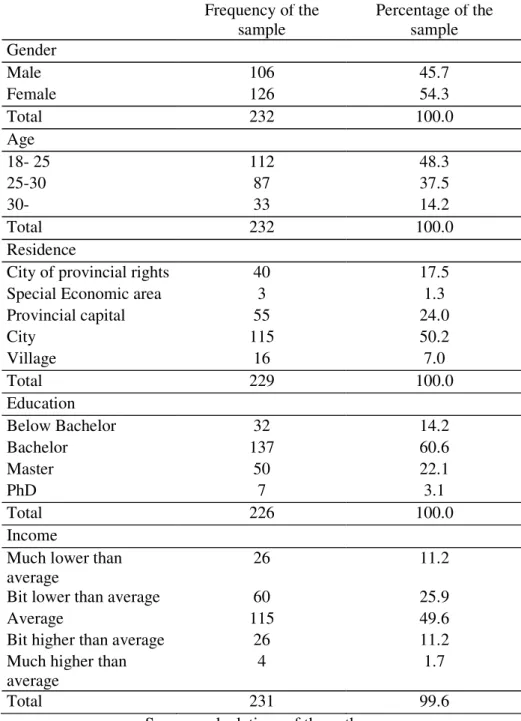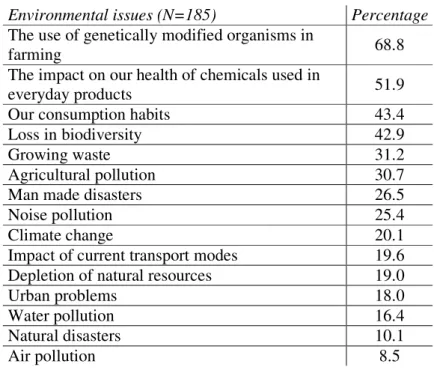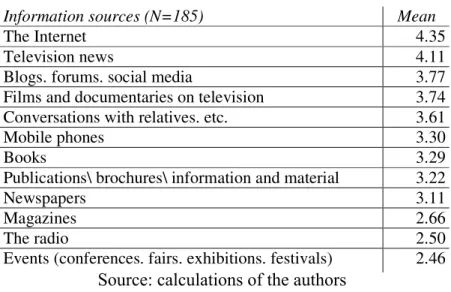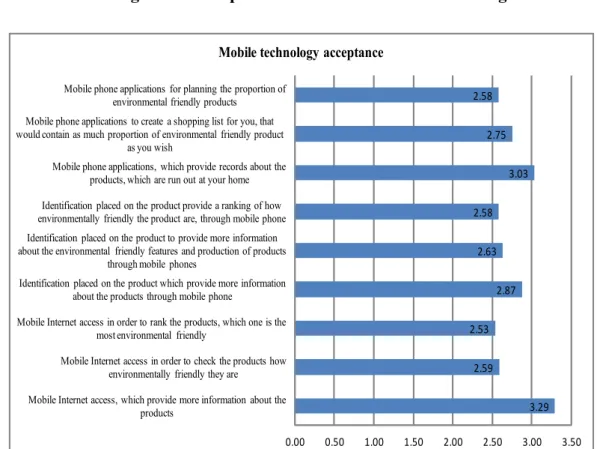Chapter 14
Mobile Phones and Sustainable Consumption in China: an Empirical Study among Young Chinese Citizens
Agnes Hofmeister-Toth, Kata Kelemen, Marianna Piskoti, Attila Endre Simay
Abstract: This millennium the number of mobile phones has exponentially grown in Western nations, however China is now the biggest mobile phone market.
The present study contains questions about the sustainability aspects of purchasing mobile phones: both of the mobile phones purchase itself, and how mobile phones are used to gather environmental and health information for consumption. The results of the present study suggest, that mobile phones became an important source of information about environmental protection issues, but the specifi c applications do not play an important role as a source of information about environmental conscious consumption yet.
Keywords: Sustainable consumption, Mobile market, Innovation acceptance
Introduction
This millennium the number of mobile phones has exponentially grown in Western nations, however China is now the biggest mobile phone market. In contrast with Western nations, where growth is slow or has stalled, the mobile market is still growing in China. In May 2011, there were more than 900 million mobile subscriptions in China (PC World 2011), approximately half of the population, and therefore further growth is expected.
With the rapid growth of the mobile industry in China, consumers are disposing of used phones more frequently, and the number of waste mobile phones in China is still unknown. The production, distribution and usage of mobile phones require more energy as the number of active mobile phones increases (Yu et al. 2010).
The present study contains questions about the sustainability aspects of purchasing mobile phones: both of the mobile phones purchase itself, and how mobile phones are used to gather environmental and health information for the purchase.
As the usage of the mobile technologies has signifi cant social infl uence (Das – Mohanty 2007), in the present study the relationship of the mobile technology, environmental consciousness and environmental concerns will be discussed.
The results show how mobile technology can infl uence the way of thinking and purchasing habits of young Chinese citizens, and how this technology can foster sustainability.
Trends in Mobile Industry
There are more mobile Internet users in China than any other country, China claims to have the highest mobile Internet usage in the world (CNNIC 2010).
According to The China Internet Network Information Center (CNNIC) report, there were 420 million internet users in 2010 in China, and 277 million (65.9
%) of this amount were mobile Web users. The majority of mobile internet users also access the Web via PC or laptop, but 11.7 percent (49 million) of Web users exclusively use mobile to access the Web. However the 3G users of them is only 67 millions (PC World 2011). The number of people accessing the mobile Internet via laptops and smart phones is growing fast and is expected to overtake the PC as the most popular way to get on the Web (ITU 2010).
The United States is the dominant mobile application market, followed by China, which is the fastest growing mobile application market (Farago 2011). Downloads of new applications from China grew from 1.2% to 12% over the course of the year, from January through October (Farago 2011).
In 2010 the most popular activities using mobile internet were instant messaging (62 percent), followed by mobile search, web music, web literature, social networking, and online games, video, mobile email and mobile online payment in China (CNNIC 2010). From the view of content, the internet access using mobile web still concentrates on the leisure (music, literature and games). Similarly, games and social networking capture most of the U.S. residents’ time (Newark – French 2011).
In this study young Chinese people were asked which kind of mobile based applications they think they will use in the future, and how likely it is that they use these kind of applications to foster an environmental friendly way of consumption.
Research Results
Research Methodology
Data collection was carried out between August 2011 and September 2011 in Beijing. Total sample size was 227 respondents. The research was conducted with face-to-face interviews, and the questionnaire was in Chinese language. Data was analyzed using the SPSS software suite.
The questionnaire contained 16 questions, with 5 questions concern demographics.
Questions were focused on values, environmental attitudes, level of information about the environment, the pro-environmental behaviors of the respondents and their attitudes towards the mobile application usage fostering environmental conscious behavior.
In this paper we present the results of the questions about the information gathering habits, and the intention to use mobile phones and mobile applications to get information about environmentally friendly consumption.
Characteristics of the Sample
The respondents were young Chinese citizens, mainly students from Peking University, with average age of 24.59 years. Table 1 details the demographics of the sample.
Frequency of the sample
Percentage of the sample Gender
Male 106 45.7
Female 126 54.3
Total 232 100.0
Age
18- 25 112 48.3
25-30 87 37.5
30- 33 14.2
Total 232 100.0
Residence
City of provincial rights 40 17.5
Special Economic area 3 1.3
Provincial capital 55 24.0
City 115 50.2
Village 16 7.0
Total 229 100.0
Education
Below Bachelor 32 14.2
Bachelor 137 60.6
Master 50 22.1
PhD 7 3.1
Total 226 100.0
Income
Much lower than average
26 11.2
Bit lower than average 60 25.9
Average 115 49.6
Bit higher than average 26 11.2
Much higher than average
4 1.7
Total 231 99.6
Source: calculations of the authors
Table 1. Demographic Characteristics of the Sample
Level of Information about Environmental Issues
The respondents do not feel well informed in the questions of environmental issues (M=3.25). The majority of the respondents feel that they do not have enough information on „the use of genetically modifi ed organism in farming”. The second topic is the impact of chemicals on our health, and the third issue for the Chinese is the environmental impact of their consumption habits (see Table 2).
Table 2. Main Issues which the Respondents Feel Lack of Information (Percentage of Respondents)
Source: calculations of the authors
The most important information source is the internet (M=4.34), then the television news (M=4.17) and the mobile phones are only the 6th in the row (see Table 3), having medium importance (M=3.28).
Environmental issues (N=185) Percentage The use of genetically modified organisms in
farming 68.8
The impact on our health of chemicals used in
everyday products 51.9
Our consumption habits 43.4
Loss in biodiversity 42.9
Growing waste 31.2
Agricultural pollution 30.7
Man made disasters 26.5
Noise pollution 25.4
Climate change 20.1
Impact of current transport modes 19.6
Depletion of natural resources 19.0
Urban problems 18.0
Water pollution 16.4
Natural disasters 10.1
Air pollution 8.5
Table 3. Main Information Sources
Source: calculations of the authors
Mobile Phone Usage and Technology Acceptance
Although the respondents tend to use mobile phones in order to get general information about environmental issues, when it comes to consumption, they don’t use their mobile phones. It is interesting that though the environmental impact of consumption habits is important for the respondents, but they feel uninformed about it. During shopping the respondents do not look for additional information about the products environmental or health related characteristics (see Diagram 1).
Information sources (N=185) Mean
The Internet 4.35
Television news 4.11
Blogs. forums. social media 3.77
Films and documentaries on television 3.74
Conversations with relatives. etc. 3.61
Mobile phones 3.30
Books 3.29
Publications\ brochures\ information and material 3.22
Newspapers 3.11
Magazines 2.66
The radio 2.50
Events (conferences. fairs. exhibitions. festivals) 2.46
Concerning the environmental impact of mobile phone purchase the respondents are slightly more conscious. 18 percent of the respondents take into consideration the products environmental impact and 27 percent ensure the proper treatment of the used mobile phones.
Most likely would the respondents use the mobile internet access to get information about the product features (M=3.29). The average usage intention gets lower if the information are specifi ed as environmental friendly features of the products (M=2.59).
In the study we tested the acceptance of different type of mobile applications.
That application, which generally helps to enhance the shopping experience, helps planning the shopping lists and the necessary quantity and quality of the needed products was more likely to be used. The acceptance of those applications, which supports the environmental conscious consumption was lower (see Diagram 2).
The respondents found that application most useful, which provide records about the products that are run out at home (M=3.03). An application, that helps to create a shopping list with an exact quantity of environmentally friendly product had a lower acceptance (M=2.75). The lowest average with 2.58 score was given to those mobile phone applications, which help the user planning the proportion of environmental friendly product they wish to purchase in a month, and they can monitor purchase with mobile phone.
Source: calculations of the authors
Diagram 1. Mobile Phone Use in Environmental Conscious Decissions
Identifi cation placed on the product (for example BAR code), which provide more information about the products through mobile phone would be in use nearly in moderate likelihood (M=2.87). The probability of using the application slightly got lower, if the received information was about the product’s environmentally friendly features (M=2.63), or a ranking about it (M=2.58).
Diagram 2. Acceptance of Possible Mobile Technologies
3.29 2.59
2.53 2.87 2.63 2.58
3.03 2.75 2.58
0.00 0.50 1.00 1.50 2.00 2.50 3.00 3.50
Mobile Internet access, which provide more information about the products
Mobile Internet access in order to check the products how environmentally friendly they are
Mobile Internet access in order to rank the products, which one is the most environmental friendly
Identification placed on the product which provide more information about the products through mobile phone
Identification placed on the product to provide more information about the environmental friendly features and production of products
through mobile phones
Identification placed on the product provide a ranking of how environmentally friendly the product are, through mobile phone Mobile phone applications, which provide records about the
products, which are run out at your home Mobile phone applications to create a shopping list for you, that would contain as much proportion of environmental friendly product
as you wish
Mobile phone applications for planning the proportion of environmental friendly products
Mobile technology acceptance
Source: calculations of the authors
Conclusions
Although the mobile phone penetration is high in China, the respondents in our study are not yet open to use the new mobile technologies to get information on environmental conscious consumption. The results of the present study suggest, that mobile phones became an important source of information about environmental protection issues, but the specifi c technologies (applications) do not play an important role as a source of information about environmental conscious consumption yet. The young Chinese citizens in the sample are more likely to care about the proper treatment of the obsolete devices when they buy a new mobile phone, than the environmental friendliness of the new one.
The young people have an important role in innovation acceptance, which is also true in the acceptance of possible new mobile technologies. As we examined the young Chinese citizens in our pilot study, we found, that those innovations, which make consumption more easy or conscious more likely to be used, than those innovations, which are connected to the environmental conscious consumption.
Further research is needed to defi ne factors that secure acceptance of mobile application as a source of information on environmental conscious consumption.
References
China Internet Network Information Center (2010): Statistical Report on Internet Development in China. Available: http://www.cnnic.cn/en/index/0O/02/index.
htm [Accessed: 18.10.2011]
Das, B; Mohanty, S. (2007): Service Usability and Users’ Satisfaction in India:
An Exploratory Study on Mobile Phone Users. The Icfai Journal of Services Marketing. 5(4): 53-66.
International Telecommunication Union (2010): ITU sees 5 billion mobile subscriptions globally in 2010. Available: http://www.itu.int/newsroom/press_
releases/2010/06.html [Accessed: 18.10.2011]
PC World (2011): China Reaches 900 Million Mobile Phone Users. Available:
http://www.pcworld.com/businesscenter/article/228611/china_reaches_900_
million_mobile_phone_users.html [Accessed: 18.10.2011]
Yu, J., Williams, E., Ju, M. (2010): Analysis of material and energy consumption of mobile phones in China. Energy Policy. 38: 4135-4141.
Newark-French, C. (2011): Mobile Apps put the web in their rear-view mirror.
Available: http://blog.fl urry.com/?BBPage=1 [Accessed: 18.10.2011]
Farago, P. (2011): China: The new mobile app dragon. Available: http://blog.fl urry.
com/?BBPage=0 [Accessed: 18.10.2011]




